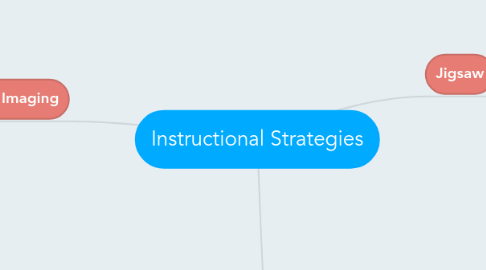
1. Focused Imaging
1.1. Description
1.1.1. Experiential Learning
1.1.2. "Teachers can encourage divergent thinking by asking students to transform a teacher guided image into several others of their own creation, to imagine various solutions for spatial or design problems, or to visualize a particular scene or event and then imagine what might happen next" (Saskatoon Public School, 2004)
1.1.3. Focused Imaging is a method of teaching that utilizes the child’s imaginations by getting them to create images in their mind.
1.1.4. Example: Mental Math - Student mentally calculate the answer to the question in their minds by creating an image.
1.1.5. Example: Story Retell - Students create the pictures for the story in their own minds, then use the imagery to recall the story.
1.2. Advantages
1.2.1. No wrong answers. The student creating the image is the only one who can see it.
1.2.2. Students draw on prior knowlege
1.2.3. Teaches students to work through ideas and problems in their minds.
1.2.4. Develops students ability to recall information
1.2.5. Helps students who are uncomfortable with being the center of attention or getting the wrong answer.
1.3. Challenges
1.3.1. Difficult to assess
1.3.2. No way of knowing if students are participating
1.4. Incorporate Technology
1.4.1. Technology can be used when teaching focused imaging for the first time. The teacher could use technology to model the image she is creating in he/her mind.
1.4.2. Technology can be us to log students answers. Using remotes students can enter their answer from a Mental Math activity. This would help with the difficulty of assessing with the student still be anonymous.
2. Jigsaw
2.1. Description:
2.1.1. Interactive Instruction
2.1.2. Students are a part of a cooperative learning group called their "home" group. Each member receives an assigned aspect of the group project, then goes and meets with other students or the "expert" group, who have the same task. Student work as a group to learn about their topic and master it well enough to teach the "home" group.
2.1.3. Example: There are many strategies to solving a multi-digit multiplication problem. Students can be assigned the task of learning how to solve a problem using a particular strategy. Then return to their home group to teach the strategy.
2.1.4. Best used in grades 3-12
2.2. Advantages
2.2.1. Useful when teaching topics with a great deal of content
2.2.2. Teaches students to work and learn cooperatively
2.2.3. Students share responsibility for each others learning.
2.3. Challenges
2.3.1. Teacher must have knowledge of all content area in order to monitor what the groups are learning and teaching others.
2.3.2. Students who do not wish to participate cause the whole group to miss out on learning a section of the assignment
2.4. Incorporate Technology
2.4.1. Students can use technology in order to present their finding. The "expert" group could work together to create a presentation that would then be shared with all "home"groups
2.4.2. Technology can be use to obtain information the group would need about their topic
